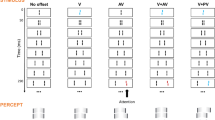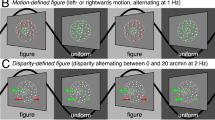Abstract
Visual analyses of form and motion proceed along parallel streams. Unified perception of moving forms requires interactions between these streams, although whether the interactions occur early or late in cortical processing remains unresolved. Using rotating outlined shapes sampled through apertures, we showed that binding local motions into global object motion depends strongly on spatial configuration. Identical local motion components are perceived coherently when they define closed configurations, but usually not when they define open configurations. Our experiments show this influence arises in early cortical levels and operates as a form-based veto of motion integration in the absence of closure.
This is a preview of subscription content, access via your institution
Access options
Subscribe to this journal
Receive 12 print issues and online access
$209.00 per year
only $17.42 per issue
Buy this article
- Purchase on Springer Link
- Instant access to full article PDF
Prices may be subject to local taxes which are calculated during checkout






Similar content being viewed by others
References
Ungerleider, L. G. & Mishkin, M. in The Analysis of Visual Behavior (eds. Ingle, D. J., Mansfield, R. J. W. & Goodale M. S.) 549–586 (MIT Press, Cambridge, Massachusetts, 1982).
Livingstone, M. S. & Hubel, D. H. Psychophysical evidence for separate channels for the perception of form, color, movement and depth. J. Neurosci. 11, 3416–3468 (1987).
DeYoe, E. A. & Van Essen, D. C. Concurrent streams in monkey visual cortex. Trends Neurosci. 11, 219–226 (1988).
Geesaman, B. J. & Andersen, R. A. The analysis of complex motion patterns by form/cue invariant MSTd neurons. J. Neurosci. 16, 4716–4732 (1996).
Braddick, O. J., O'Brien, J. M. D., Wattam-Bell, J., Atkinson, A. & Turner, R. Form and motion coherence activate independent, but not dorsal/ventral segregated, networks in the human brain. Curr. Biol. 10, 731–734 (2000).
Anderson, B. L. & Sinha, P. Reciprocal interactions between occlusion and motion computations. Proc. Natl. Acad. Sci. USA 94, 3477–3480 (1997).
Watanabe, T. Velocity decomposition and surface decomposition: reciprocal interactions between motion and form processing. Vision Res. 37, 2879–2889 (1997).
Tse, P., Cavanagh, P. & Nakayama, K. in High-Level Motion Processing—Computational, Neurobiological and Psychophysical Perspectives (ed. Watanabe, T.) 245–266 (MIT Press, Cambridge, Massachusetts, 1998).
Rao, S. C., Rainer, G. & Miller, E. K. Integration of what and where in the primate prefrontal cortex. Science 276, 821–824 (1997).
Malpeli, J. G., Schiller, P. H. & Colby, C. L. Response properties of single cells in monkey striate cortex during reversible inactivation of individual lateral geniculate laminae. J. Neurophysiol. 46, 1102–1119 (1981).
Nealy, T. A. & Maunsell, J. H. R. Magnocellular and parvocellular contributions to the responses of neurons in macaque striate cortex. J. Neurosci. 14, 2069–2079 (1994).
Sawatari, A. & Callaway, E. M. Convergence of magno- and parvocellular pathways in layer 4B of macaque primary visual cortex. Nature 380, 442–446 (1996).
Lorenceau, J. & Shiffrar, M. The influence of terminators on motion integration across space. Vision Res. 32, 263–273 (1992).
Alais, D., van der Smagt, M. J., van den Berg, A. V. & van de Grind, W. A. Local and global factors affecting the coherent motion of gratings presented in multiple apertures. Vision Res. 38, 1581–1591 (1998).
Shiffrar, M. & Lorenceau, J. Increased motion linking across edges with decreased luminance contrast, edge width and duration. Vision Res. 36, 2061–2068 (1996).
Lorenceau, J. & Zago, L. Cooperative and competitive spatial interactions in motion integration. Vis. Neurosci. 16, 755–770 (1999).
Morgan, M. J., Findlay J. M., & Watt, R. J. Aperture viewing: a review and a synthesis. Q. J. Exp. Psychol. 34A, 211–233 (1982).
Adelson, E. H. & Movshon, J. A. Phenomenal coherence of moving visual patterns. Nature 300, 523–525 (1982).
Wilson, H. R. & Kim, J. A model for motion coherence and transparency. Vis. Neurosci. 11, 1205–1220 (1994).
Guilford, J. P. Psychometric Methods (New York, McGraw-Hill, 1954).
Merigan, W. H. & Maunsell, J. H. How parallel are the primate visual pathways? Annu. Rev. Neurosci. 16, 369–402 (1993).
Shapley, R. Visual sensitivity and parallel retinocortical channels. Annu. Rev. Psychol. 41, 635–658 (1990).
Tootell, R. B. et al. Functional analysis of V3A and related areas in human visual cortex. J. Neurosci. 17, 7060–7078 (1997).
Shimojo, S., Silverman, G. & Nakayama, K. Occlusion and the solution to the aperture problem for motion. Vision Res. 29, 619–626 (1989).
Derrington, A. M. & Lennie, P. Spatial and temporal contrast sensitivities of neurones in lateral geniculate nucleus of macaque. J. Physiol. (Lond.) 357, 219–240 (1984).
Livingstone, M. S. & Hubel, D. H. Do the relative mapping densities of the magno- and parvocellular systems vary with eccentricity? J. Neurosci. 11, 4334–4339 (1987).
Duffy, C. J. & Wurtz, R. H. Response of monkey MST neurons to optic flow stimuli with shifted centers of motion. J. Neurosci. 15, 5192–5208 (1995).
Sereno, A. B. & Maunsell, J. H. R. Shape selectivity in primate lateral intraparietal cortex. Nature 395, 500–503 (1998).
Kellman, P. J. & Shipley, T. F. A theory of visual interpolation in object perception. Cognit. Psychol. 23, 141–221 (1991).
Miyashita, Y. & Hayashi, T. Neural representation of visual objects: encoding and top-down activation. Curr. Opin. Neurobiol. 10, 187–194 (2000).
Sigman, M. & Gilbert, C. D. Learning to find a shape. Nat. Neurosci. 3, 264–269 (2000).
Sugita, Y. Grouping of image fragments in primary visual cortex. Nature 401, 269–272 (1999).
Kovacs, I. & Julesz, B. A closed curve is much more than an incomplete one: effect of closure in figure-ground segmentation. Proc. Natl. Acad. Sci. USA 90, 7495–7497 (1993).
Elder, J. H. & Zucker, S. W. Evidence for boundary-specific grouping. Vision Res. 38, 143–152 (1998).
Yin, C., Kellman, P. J. & Shipley, T. F. Surface completion complements boundary interpolation in the visual integration of partly occluded objects. Perception 26, 1459–1479 (1997).
Rensink, R. A. & Enns, J. T. Early completion of occluded objects. Vision Res. 38, 2489–2505 (1998).
Grossberg, S. & Mingolla, E. Neural dynamics of form perception: boundary completion. Psychol. Rev. 92, 173–211 (1985).
Grossberg, S. Cortical dynamics of three-dimensional figure-ground perception of two-dimensional pictures. Psychol. Rev. 104, 618–658 (1997).
Lamme, V. A., Rodriguez-Rodriguez, V. & Spekreijse, H. Separate processing dynamics for texture elements, boundaries and surfaces in primary visual cortex of the macaque monkey. Cereb. Cortex 9, 406–413 (1999).
Field, D. J., Hayes, A. & Hess, R. F. Contour integration by the human visual system: evidence for a local “association field.” Vision Res. 33, 173–193 (1993).
Polat, U. & Sagi, D. The architecture of perceptual spatial interactions. Vision Res. 34, 73–78 (1994).
Gilbert, C. D. Horizontal integration and cortical dynamics. Neuron 9, 1–13 (1992).
Kapadia, M. K., Ito, M., Gilbert, C. D. & Westheimer, G. Improvement in visual sensitivity by changes in local context: parallel studies in human observers and in V1 of alert monkeys. Neuron 15, 843–856 (1995).
Pasupathy, A. & Connor, C. E. Responses to contour features in Macaque area V4. J. Neurophysiol. 82, 2490–2502 (1999).
Gallant, J. L., Connor, C. E., Rakshit, S., Lewis, J. W. & Van Essen, D. C. Neural responses to polar, hyperbolic, and Cartesian gratings in area V4 of the macaque monkey. J. Neurophysiol. 76, 2718–2739 (1996).
Kobatake, E. & Tanaka, K. Neuronal selectivities to complex object features in the ventral visual pathway of the macaque cortex. J. Neurophysiol. 71, 856–867 (1994).
Hupé, J. M. et al. Cortical feedback improves discrimination between figure and background by V1, V2 and V3 neurons. Nature 394, 784–787 (1998).
Hildreth, E. & Koch, C. The analysis of visual motion: From computational theory to neuronal mechanisms. Annu. Rev. Neurosci. 10, 477–533 (1987).
Yuille, A. L. & Grzywacz, N. M. A computational theory for the perception of coherent visual motion. Nature 333, 71–74 (1988).
Acknowledgements
Supported by the CNRS and by a Long-Term Fellowship from Human Frontiers Science Programme to D.A. Thanks to D. Shulz and Y. Frégnac for discussions.
Author information
Authors and Affiliations
Corresponding author
Rights and permissions
About this article
Cite this article
Lorenceau, J., Alais, D. Form constraints in motion binding. Nat Neurosci 4, 745–751 (2001). https://doi.org/10.1038/89543
Received:
Accepted:
Issue Date:
DOI: https://doi.org/10.1038/89543
This article is cited by
-
A neural correlate of perceptual segmentation in macaque middle temporal cortical area
Nature Communications (2022)
-
A Cortical-Inspired Geometry for Contour Perception and Motion Integration
Journal of Mathematical Imaging and Vision (2014)
-
Ongoing eye movements constrain visual perception
Nature Neuroscience (2006)
-
What constitutes an efficient reference frame for vision?
Nature Neuroscience (2002)



